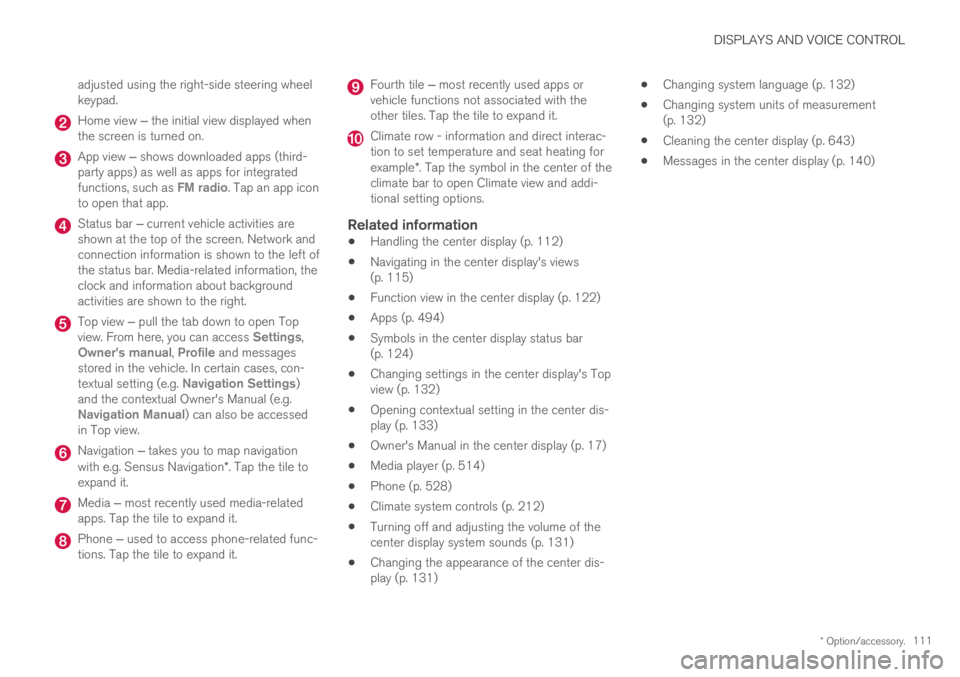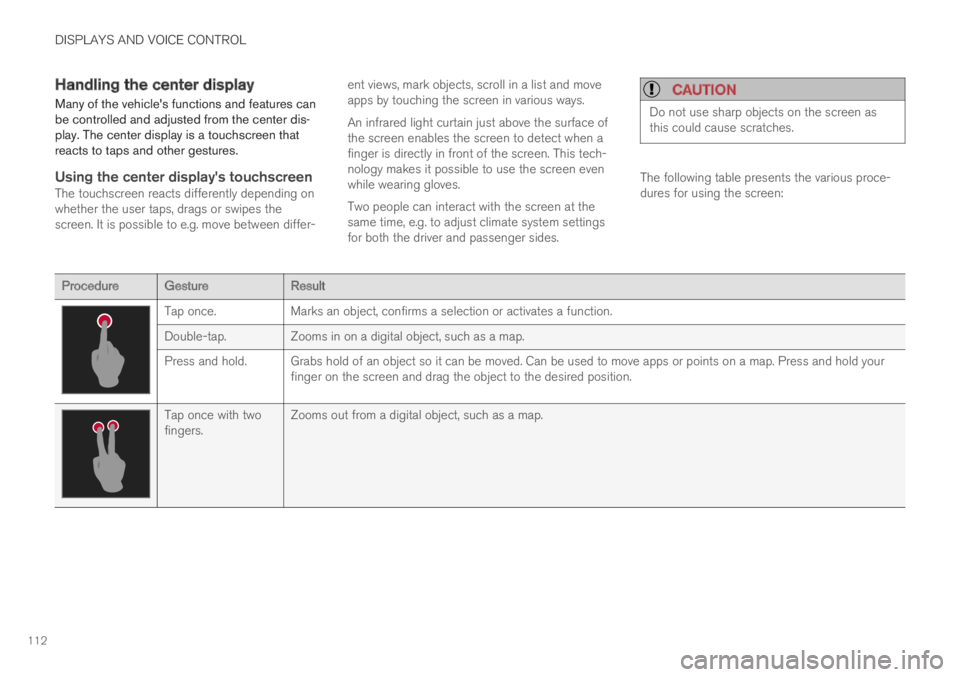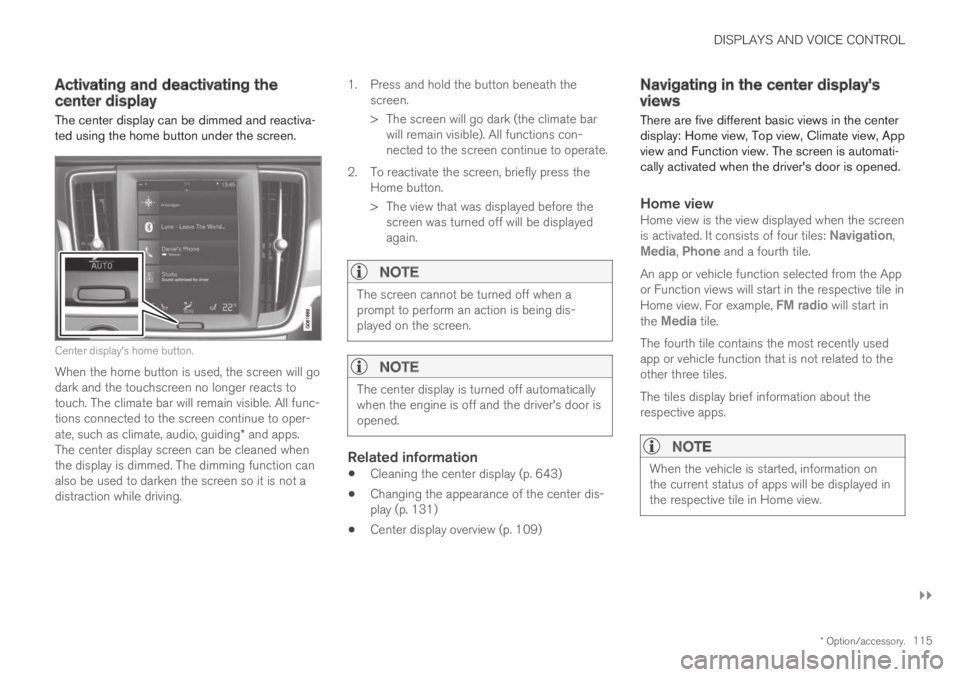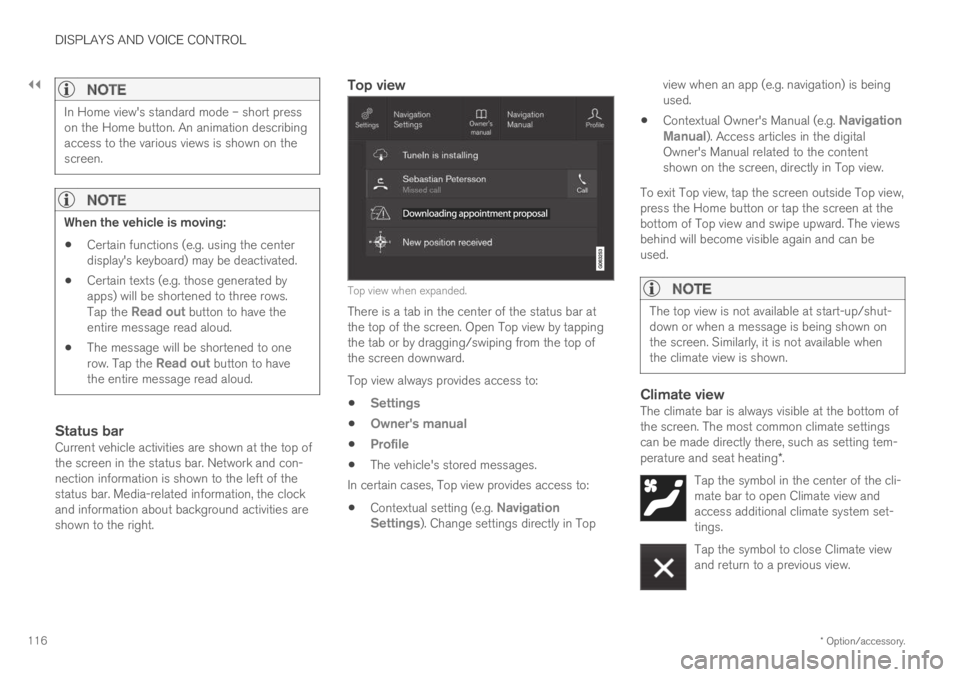2019 VOLVO XC60 TWIN ENGINE climate control
[x] Cancel search: climate controlPage 7 of 695

5
SEATS AND STEERING WHEEL
Manual front seats184
Power* front seats185
Adjusting the power* front seats185
Storing positions for seats, mirrorsand head-up display*186
Using stored positions for seats, mir-rors and head-up display*187
Front seat massage* settings188
Adjusting front seat massage settings*189
Adjusting* front seat cushion length189
Adjusting front seat side bolster settings*190
Adjusting front seat lumbar support*191
Adjusting the passenger seat fromthe driver's seat*192
Folding down the rear seat backrests193
Adjusting the rear seat head restraints196
Steering wheel controls and horn197
Adjusting the steering wheel198
CLIMATE CONTROL
Climate200
Climate zones200
Climate control sensors200
Perceived temperature201
Climate control system voice commands201
Air quality202
Clean Zone*203
Clean Zone Interior Package*204
Interior Air Quality System*204
Activating and deactivating the airquality sensor*205
Passenger compartment air filter205
Air distribution205
Adjusting air distribution206
Opening, closing and directing air vents207
Air distribution options209
Climate system controls212
Activating and deactivating powerfront seats*213
Activating and deactivating theheated front seat*214
Activating and deactivating theheated rear seats*214
Activating and deactivating front seatventilation*215
Activating and deactivating theheated steering wheel*215
Activating and deactivating automaticsteering wheel heating*216
Activating auto climate control216
Activating and deactivating recirculation217
Activating and deactivating the recir-culation timer setting218
Activating and deactivating max defroster218
Activating and deactivating theheated windshield*219
Activating and deactivating automaticwindshield heating*220
Activating and deactivating theheated rear window and door mirrors221
Automatically activating and deacti-vating the heated rear window anddoor mirrors
221
Setting the blower speed for thefront seats222
Setting the temperature for the frontseats222
Synchronize temperature223
Activating and deactivating air condi-tioning224
Parking climate224
Preconditioning225
Starting and stopping preconditioning226
Page 15 of 695

13
LOADING, STORAGE AND
PASSENGER COMPARTMENT
Passenger compartment interior588
Tunnel console589
Electrical outlets590
Using the electrical outlets592
Using the glove compartment593
Sun visors594
Cargo compartment595
Loading recommendations595
Roof loads and load carriers596
Grocery bag holders597
Load anchoring eyelets598
Rear seat ski hatch598
Installing and removing the cargocompartment cover*598
Operating the cargo compartment cover*600
Installing and removing the steelcargo grid*602
Installing and removing the cargo net*603
MAINTENANCE AND SERVICE
Volvo's service program608
Data transfer between vehicle andworkshop over Wi-Fi610
Download Center611
Handling system updates via Down-load Center611
Vehicle status612
Scheduling service and repairs613
Sending vehicle information to theworkshop614
Hoisting the vehicle616
Opening and closing the hood618
Climate control system service619
Replacing a windshield with head-updisplay*619
Engine compartment overview620
Engine oil621
Checking and filling engine oil622
Refilling coolant623
Replacing bulbs624
Start battery625
Hybrid battery629
Battery symbols630
Fuses and fuseboxes630
Replacing fuses631
Fuses in the engine compartment632
Fuses under the glove compartment636
Fuses in the cargo compartment639
Cleaning the interior643
Cleaning the center display643
Cleaning the head-up display*644
Cleaning fabric upholstery and ceil-ing liner645
Cleaning the seat belt645
Cleaning floor mats and inlay mats645
Cleaning leather upholstery646
Cleaning the leather steering wheel647
Cleaning interior plastic, metal andwood surfaces648
Cleaning the exterior648
Polishing and waxing649
Hand washing649
Automatic car washes651
High-pressure washing652
Cleaning the wiper blades652
Cleaning exterior plastic, rubber andtrim components653
Cleaning rims654
Corrosion protection654
Paintwork655
Touching up minor paint damage655
Page 92 of 695

||
DISPLAYS AND VOICE CONTROL
90
This calculation is based on average fuel con-sumption during the last 30 km (20 miles) andthe amount of fuel remaining in the tank.
When the gauge displays "----", there is notenough fuel remaining to calculate the remainingmileage. Refuel as soon as possible.
NOTE
This may vary if your driving style changes.
An economical driving style will generallyincrease how far you can drive on a certainamount of fuel.
Distance to discharged battery
The gauge shows the approximate dis-tance that can be driven with theremaining current in the hybrid battery.
When the gauge displays "----", there is littlecharge remaining in the battery and distancecannot be reliably calculated.
This calculation is based on average consump-tion with a normally loaded vehicle in normal driv-ing conditions, and takes into account whetherthe air conditioning is on or off. Changing drivemodes from Hybrid to Pure may increase thecalculated distance because Pure mode hasreduced climate control settings (ECO Climate).
NOTE
This may vary if your driving style changes.
An economical driving style will generallyincrease how far you can drive on a certainamount of fuel.
Starting values for fully charged hybrid
battery
Because it is difficult to predict driving style andother factors that affect the range of electricmotors, Volvo uses a starting value when thevehicle is fully charged. This starting value pro-vides an "up to" amount instead of a predictionon the range of the electric current in the motor.The difference in starting value between Hybridand Pure is because the vehicle is permitted touse more current from the hybrid battery in Puremode, and because the vehicle switches to ECOClimate.
Mileage when using electric motor
To achieve the longest possible mileage whenusing the electric motor, the driver of an electricvehicle also needs to think about conservingelectricity. The more electricity consumers(stereo, heated windows/mirrors/seats, very coldair from climate control system, etc.) that areactive, the shorter the potential mileage.
NOTE
In addition to high electrical consumption inthe passenger compartment, rapid accelera-tion, sudden braking, high speeds, heavyloads, low ambient temperatures and drivingup hills can reduce possible driving distance.
Tourist - alternative speedometer
The alternative digital speedometer makes it eas-ier to drive in countries where speed limit signsare shown in a different measurement unit thanthe one shown in the vehicle's gauges.
When used, the digital speed is displayed in theopposite unit to that shown in the analog speed-ometer. If mph is used in the analog speedome-ter, the equivalent speed in km/h will be shownin the digital speedometer.
Related information
Displaying trip data in the instrument panel(p. 91)
Resetting the trip odometer (p. 92)
Displaying trip statistics in the center display(p. 92)
Instrument panel (p. 84)
Changing system units of measurement(p. 132)
Page 113 of 695

DISPLAYS AND VOICE CONTROL
* Option/accessory.111
adjusted using the right-side steering wheelkeypad.
Home view ‒ the initial view displayed whenthe screen is turned on.
App view ‒ shows downloaded apps (third-party apps) as well as apps for integratedfunctions, such as FM radio. Tap an app iconto open that app.
Status bar ‒ current vehicle activities areshown at the top of the screen. Network andconnection information is shown to the left ofthe status bar. Media-related information, theclock and information about backgroundactivities are shown to the right.
Top view ‒ pull the tab down to open Topview. From here, you can access Settings,Owner's manual, Profile and messagesstored in the vehicle. In certain cases, con-textual setting (e.g. Navigation Settings)and the contextual Owner's Manual (e.g.Navigation Manual) can also be accessedin Top view.
Navigation ‒ takes you to map navigationwith e.g. Sensus Navigation*. Tap the tile toexpand it.
Media ‒ most recently used media-relatedapps. Tap the tile to expand it.
Phone ‒ used to access phone-related func-tions. Tap the tile to expand it.
Fourth tile ‒ most recently used apps orvehicle functions not associated with theother tiles. Tap the tile to expand it.
Climate row - information and direct interac-tion to set temperature and seat heating forexample*. Tap the symbol in the center of theclimate bar to open Climate view and addi-tional setting options.
Related information
Handling the center display (p. 112)
Navigating in the center display's views(p. 115)
Function view in the center display (p. 122)
Apps (p. 494)
Symbols in the center display status bar(p. 124)
Changing settings in the center display's Topview (p. 132)
Opening contextual setting in the center dis-play (p. 133)
Owner's Manual in the center display (p. 17)
Media player (p. 514)
Phone (p. 528)
Climate system controls (p. 212)
Turning off and adjusting the volume of thecenter display system sounds (p. 131)
Changing the appearance of the center dis-play (p. 131)
Changing system language (p. 132)
Changing system units of measurement(p. 132)
Cleaning the center display (p. 643)
Messages in the center display (p. 140)
Page 114 of 695

DISPLAYS AND VOICE CONTROL
112
Handling the center display
Many of the vehicle's functions and features canbe controlled and adjusted from the center dis-play. The center display is a touchscreen thatreacts to taps and other gestures.
Using the center display's touchscreen
The touchscreen reacts differently depending onwhether the user taps, drags or swipes thescreen. It is possible to e.g. move between differ-
ent views, mark objects, scroll in a list and moveapps by touching the screen in various ways.
An infrared light curtain just above the surface ofthe screen enables the screen to detect when afinger is directly in front of the screen. This tech-nology makes it possible to use the screen evenwhile wearing gloves.
Two people can interact with the screen at thesame time, e.g. to adjust climate system settingsfor both the driver and passenger sides.
CAUTION
Do not use sharp objects on the screen asthis could cause scratches.
The following table presents the various proce-dures for using the screen:
ProcedureGestureResult
Tap once.Marks an object, confirms a selection or activates a function.
Double-tap.Zooms in on a digital object, such as a map.
Press and hold. Grabs hold of an object so it can be moved. Can be used to move apps or points on a map. Press and hold yourfinger on the screen and drag the object to the desired position.
Tap once with twofingers.Zooms out from a digital object, such as a map.
Page 117 of 695

DISPLAYS AND VOICE CONTROL
}}
* Option/accessory.115
Activating and deactivating thecenter display
The center display can be dimmed and reactiva-ted using the home button under the screen.
Center display's home button.
When the home button is used, the screen will godark and the touchscreen no longer reacts totouch. The climate bar will remain visible. All func-tions connected to the screen continue to oper-ate, such as climate, audio, guiding* and apps.The center display screen can be cleaned whenthe display is dimmed. The dimming function canalso be used to darken the screen so it is not adistraction while driving.
1.Press and hold the button beneath thescreen.
> The screen will go dark (the climate barwill remain visible). All functions con-nected to the screen continue to operate.
2. To reactivate the screen, briefly press theHome button.
> The view that was displayed before thescreen was turned off will be displayedagain.
NOTE
The screen cannot be turned off when aprompt to perform an action is being dis-played on the screen.
NOTE
The center display is turned off automaticallywhen the engine is off and the driver's door isopened.
Related information
Cleaning the center display (p. 643)
Changing the appearance of the center dis-play (p. 131)
Center display overview (p. 109)
Navigating in the center display'sviews
There are five different basic views in the centerdisplay: Home view, Top view, Climate view, Appview and Function view. The screen is automati-cally activated when the driver's door is opened.
Home view
Home view is the view displayed when the screenis activated. It consists of four tiles: Navigation,Media, Phone and a fourth tile.
An app or vehicle function selected from the Appor Function views will start in the respective tile inHome view. For example, FM radio will start inthe Media tile.
The fourth tile contains the most recently usedapp or vehicle function that is not related to theother three tiles.
The tiles display brief information about therespective apps.
NOTE
When the vehicle is started, information onthe current status of apps will be displayed inthe respective tile in Home view.
Page 118 of 695

||
DISPLAYS AND VOICE CONTROL
* Option/accessory.116
NOTE
In Home view's standard mode – short presson the Home button. An animation describingaccess to the various views is shown on thescreen.
NOTE
When the vehicle is moving:
Certain functions (e.g. using the centerdisplay's keyboard) may be deactivated.
Certain texts (e.g. those generated byapps) will be shortened to three rows.Tap the Read out button to have theentire message read aloud.
The message will be shortened to onerow. Tap the Read out button to havethe entire message read aloud.
Status bar
Current vehicle activities are shown at the top ofthe screen in the status bar. Network and con-nection information is shown to the left of thestatus bar. Media-related information, the clockand information about background activities areshown to the right.
Top view
Top view when expanded.
There is a tab in the center of the status bar atthe top of the screen. Open Top view by tappingthe tab or by dragging/swiping from the top ofthe screen downward.
Top view always provides access to:
Settings
Owner's manual
Profile
The vehicle's stored messages.
In certain cases, Top view provides access to:
Contextual setting (e.g. NavigationSettings). Change settings directly in Top
view when an app (e.g. navigation) is beingused.
Contextual Owner's Manual (e.g. NavigationManual). Access articles in the digitalOwner's Manual related to the contentshown on the screen, directly in Top view.
To exit Top view, tap the screen outside Top view,press the Home button or tap the screen at thebottom of Top view and swipe upward. The viewsbehind will become visible again and can beused.
NOTE
The top view is not available at start-up/shut-down or when a message is being shown onthe screen. Similarly, it is not available whenthe climate view is shown.
Climate view
The climate bar is always visible at the bottom ofthe screen. The most common climate settingscan be made directly there, such as setting tem-perature and seat heating*.
Tap the symbol in the center of the cli-mate bar to open Climate view andaccess additional climate system set-tings.
Tap the symbol to close Climate viewand return to a previous view.
Page 120 of 695

||
DISPLAYS AND VOICE CONTROL
118
If there are many functions, you can also scrolldownward through the view. This is done bysweeping/dragging from the bottom upwards.
Unlike in App view, where you tap an app to openit, in Function view, tapping a function activates ordeactivates it. Certain functions (trigger func-tions) open in their own window when tapped.
To return to Home view, swipe the screen from
right to left6 or press the Home button.
Related information
Handling tiles in the center display (p. 119)
Symbols in the center display status bar(p. 124)
Changing settings in the center display's Topview (p. 132)
Opening contextual setting in the center dis-play (p. 133)
Owner's Manual in the center display (p. 17)
Driver profiles (p. 136)
Climate system controls (p. 212)
Apps (p. 494)
Function view in the center display (p. 122)
Center display overview (p. 109)
6Applies for left-hand drive vehicles. For right-hand drive vehicles, swipe in the other direction.